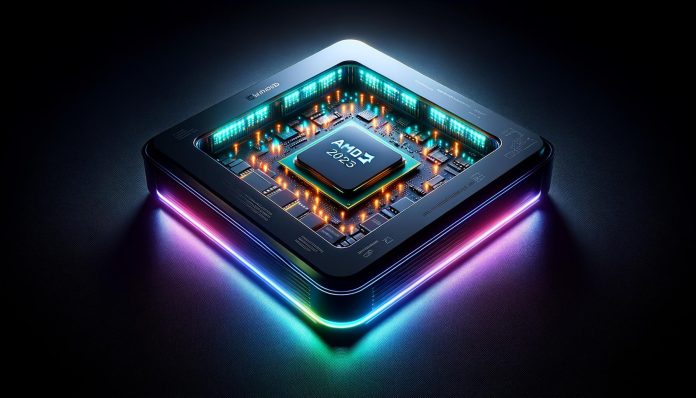As the world of technology continues to advance at a breathtaking pace, the anticipation surrounding each new generation of processors reaches a fever pitch. The upcoming AMD CPU for 2025 is no exception. With a legacy of pushing the boundaries of performance, efficiency, and innovation, AMD has consistently been at the forefront of the semiconductor industry.
This latest release promises to be a game-changer, poised to redefine our expectations of what a central processing unit can achieve.
The upcoming 2025 AMD CPUs are set to introduce a host of groundbreaking features and enhancements that cater to both consumer and enterprise markets. From gamers seeking unparalleled frame rates to data centers requiring robust computational power, this new processor aims to meet a diverse array of requirements. As we delve into the specifics of its architecture advancements, technological innovations, and market impact, it becomes clear that AMD is not just keeping pace with the competition but is setting new standards for the industry.
In this article, we will explore the intricacies of the new CPU’s design, the technological marvels it incorporates, and the broader implications for the tech landscape. By examining these elements, we can gain a comprehensive understanding of how AMD’s 2025 CPU will shape the future of computing, offering a glimpse into the next era of digital transformation.
Architecture Advancements
As the semiconductor industry continues to evolve at a rapid pace, AMD’s upcoming CPU for 2025 is poised to bring a host of groundbreaking architecture advancements. These innovations are set to redefine performance benchmarks and provide a substantial leap forward for computing technology. In this section, we will delve into three major aspects of these advancements: the new chip design, improved power efficiency, and enhanced performance metrics.
New Chip Design
The centerpiece of AMD’s upcoming CPU is its revolutionary new chip design. Leveraging cutting-edge 3D stacking technology, AMD has managed to cram more transistors into a smaller footprint, thus significantly increasing computational power while maintaining a compact form factor. This new design incorporates a modular architecture, allowing for greater flexibility and scalability.
By decoupling various components such as the CPU cores, GPU, and memory controllers, AMD has created a more adaptable platform, capable of catering to a wide range of applications from high-performance gaming to enterprise-level computing.
The new chip design also features an enhanced interconnect system, which drastically reduces latency and increases data transfer speeds between different modules. This innovation ensures that the CPU operates at peak efficiency, even under heavy workloads. Additionally, AMD has introduced a more robust thermal management system, which incorporates advanced cooling solutions to maintain optimal operating temperatures, thereby extending the lifespan of the CPU.
Improved Power Efficiency
In an era where sustainability and energy efficiency are paramount, AMD’s 2025 CPU stands out with its remarkable improvements in power efficiency. By adopting a more refined 5nm manufacturing process, AMD has been able to reduce power leakage and increase overall energy efficiency. This translates to lower power consumption without compromising on performance, making it an ideal choice for both high-performance and energy-conscious applications.
Moreover, AMD has implemented adaptive power management features that dynamically adjust power usage based on workload demands. This intelligent power management system can throttle down power consumption during low-intensity tasks and ramp it up during high-performance operations, ensuring that energy is used judiciously. These enhancements not only reduce the carbon footprint but also result in lower operating costs for consumers and enterprises alike.
Enhanced Performance Metrics
Performance has always been a critical factor for CPUs, and AMD’s 2025 offering does not disappoint. With the integration of new architectural features and optimizations, the upcoming CPU promises significant gains in performance metrics. The new chip design, coupled with higher clock speeds and increased core counts, ensures that the CPU can handle even the most demanding tasks with ease.
One of the standout features is the improved instruction per cycle (IPC) performance, which boosts the efficiency of each CPU core. This enhancement is particularly beneficial for applications that rely heavily on single-threaded performance, such as gaming and certain scientific computations. Additionally, the CPU’s multi-threading capabilities have been enhanced, allowing for better parallel processing and improved overall throughput.
AMD has also focused on optimizing the CPU for specific workloads by incorporating specialized accelerators and enhanced computational units. These dedicated components are designed to handle tasks such as machine learning, cryptographic functions, and real-time data processing more efficiently, thereby offloading work from the general-purpose cores and improving overall performance.
In summary, AMD’s upcoming CPU for 2025 showcases a plethora of architecture advancements that are set to elevate the computing experience to new heights. With a revolutionary chip design, improved power efficiency, and enhanced performance metrics, this CPU is poised to set a new standard in the industry and pave the way for future innovations.
Technological Innovations
As AMD gears up to release its highly anticipated CPU lineup in 2025, the spotlight is firmly on the groundbreaking technological innovations that promise to redefine industry standards. This section delves into how AMD is leveraging cutting-edge technology to maintain its competitive edge and deliver unparalleled computing experiences.
Integration of AI Features
One of the most compelling advancements in AMD’s upcoming CPUs is the seamless integration of Artificial Intelligence (AI) features. These new processors are designed with AI accelerators embedded directly into the silicon, enabling real-time machine learning tasks and enhancing overall system intelligence. This integration facilitates predictive performance adjustments, smarter resource allocation, and improved security measures.
AI-driven optimizations also promise to enhance everyday applications—from more responsive virtual assistants to advanced image and video processing capabilities, providing users with a more intuitive and efficient computing experience.
Advanced Manufacturing Process
In 2025, AMD is set to adopt an advanced manufacturing process that pushes the boundaries of semiconductor technology. Utilizing a cutting-edge 3nm process node, these new CPUs will offer significant improvements in both performance and energy efficiency. This miniaturization allows for a higher transistor density, translating to faster processing speeds and reduced power consumption.
The advanced manufacturing process also ensures better thermal management, which is crucial for maintaining high performance levels in demanding applications such as gaming, content creation, and data analysis. By staying at the forefront of manufacturing technology, AMD is poised to deliver CPUs that are not only more powerful but also more eco-friendly.
Support for Next-Gen Peripherals
In an era where peripheral devices are becoming increasingly sophisticated, AMD’s 2025 CPUs are designed to offer robust support for next-generation peripherals. These processors will feature enhanced compatibility with the latest PCIe 5.0 standard, offering higher data transfer rates and improved connectivity for GPUs, SSDs, and other high-speed components. Additionally, support for DDR5 memory will provide greater bandwidth and efficiency, catering to the growing demands of modern software and applications.
AMD is also focusing on integrating advanced USB4 and Thunderbolt 4 technologies, ensuring seamless connectivity and faster data transfer speeds for a wide range of devices. This forward-looking approach guarantees that users can fully leverage the capabilities of their cutting-edge peripherals, making AMD’s new CPUs a future-proof investment.
In conclusion, AMD’s 2025 CPU lineup is set to introduce a host of technological innovations that will elevate the computing experience to new heights. From AI integration and advanced manufacturing processes to comprehensive support for next-gen peripherals, these advancements underscore AMD’s commitment to pushing the envelope and setting new industry benchmarks.
Market Impact
The introduction of AMD’s 2025 CPU lineup is poised to redefine the competitive landscape in the semiconductor industry. Historically, AMD has been locked in a fierce rivalry with Intel, with each company striving to outdo the other in terms of performance, power efficiency, and price-to-performance ratios. The 2025 CPUs from AMD are expected to leverage their architectural advancements and technological innovations to offer significant gains over their predecessors.
This new lineup could potentially deliver a knockout blow in key performance metrics, such as single-thread and multi-thread capabilities, which have traditionally been battlegrounds for market share.
Moreover, AMD’s focus on integrating AI features and adopting an advanced manufacturing process can provide a substantial edge over competitors. These enhancements are not just incremental but transformative, aligning well with industry trends towards AI-driven computing and more efficient, smaller, and faster chip designs. Consequently, AMD’s 2025 CPUs could attract a broad spectrum of customers, from high-end gaming enthusiasts and professional content creators to enterprise clients needing robust data center solutions.
Consumer Expectations
Consumer expectations for AMD’s 2025 CPUs are sky-high, fueled by the company’s recent successes and the tantalizing promise of next-generation technology. One of the most anticipated aspects is the improved power efficiency, which is expected to translate into longer battery life for laptops and lower energy costs for data centers. For gamers and professionals alike, the enhanced performance metrics could mean smoother experiences, faster rendering times, and more efficient multitasking.
Additionally, the integration of AI features is likely to resonate well with consumers who are increasingly adopting AI-driven applications, from voice assistants to complex data analysis tools. The support for next-gen peripherals, such as DDR5 memory and PCIe 5.0, further aligns with consumer demand for cutting-edge technology that future-proofs their investments.
While AMD has set a high bar for itself, the company’s consistent track record of delivering on its promises gives consumers reason to be optimistic. Pre-release hype and early benchmarks can only stoke this anticipation further, setting the stage for a potentially record-breaking product launch.
Long-term Projections
Looking ahead, AMD’s 2025 CPUs could have far-reaching implications for the company’s long-term market position and the broader semiconductor industry. If the new CPUs meet or exceed expectations, AMD could solidify its reputation as a leader in CPU innovation, potentially capturing more market share from Intel and other competitors. This shift could have a ripple effect, influencing pricing strategies, research and development priorities, and even mergers and acquisitions within the industry.
From a financial perspective, the successful adoption of these CPUs could lead to robust revenue growth and increased shareholder value. AMD’s commitment to sustainability and power efficiency could also attract environmentally-conscious investors, adding another layer of long-term appeal.
Furthermore, the technological innovations introduced in the 2025 CPUs could set new industry standards, pushing competitors to evolve and innovate in response. This dynamic could accelerate the pace of technological advancements across the board, benefiting consumers and businesses alike.
In summary, the market impact of AMD’s 2025 CPUs extends beyond immediate sales figures and into the realms of competitive dynamics, consumer satisfaction, and long-term industry trends. If AMD can deliver on its ambitious promises, the 2025 CPU lineup could mark a pivotal moment in the company’s history and the future of computing technology.
Conclusion
As we look ahead to 2025, AMD’s forthcoming CPUs promise to be a significant leap forward in both technology and performance. The advancements in architecture, highlighted by a revolutionary chip design, improved power efficiency, and enhanced performance metrics, set a new benchmark for the industry. These enhancements are not only expected to meet the growing demands of modern computing but also to push the envelope in terms of what we can achieve with consumer and enterprise-level processors.





.jpg?w=100&resize=100,70&ssl=1)
